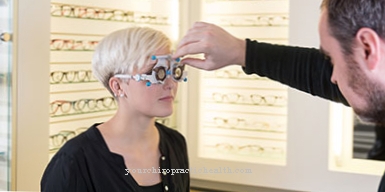The diagnosis Mouse arm or RSI syndrome (Repetitive Strain Injury) refers to pain in the neck and hand caused by daily computer work. Does the job have to be changed or is there a chance of recovery?
What is a mouse arm?
.jpg)
© Ralf Geithe - stock.adobe.com
A Mouse arm or RSI syndrome occurs when the neck-shoulder-arm area is permanently overloaded. Secretaries are particularly likely to have this disease.
For this reason, the mouse arm is also called Repetitive Strain Injury Syndrome (RSI syndrome) in technical terms. The mouse arm manifests itself first in a discomfort and in the loss of strength of the arm. Noticeable: pain only occurs later. Further signs of RSI syndrome are tingling or numbness in the fingers, hands or in the forearm, which later lead to more or less severe pain.
The joints in the hands, arms and shoulders can stiffen. Especially in the morning, the mouse arm often has painful and cold hands. The mouse arm can also cause muscle spasms and incoordination in the extremities concerned.
causes
From Mouse arm frequent writers are particularly affected. This includes copywriters as well as graphic artists and journalists. You sit in front of your computer for many hours every day and do thousands of clicks with your mouse. These constant sequences of movements over time overload tendons, muscles and nerves.
In addition, the surrounding tissue is permanently irritated. A workstation that is not ergonomically designed often causes the RSI syndrome. A mouse arm is also caused by stress, poor body awareness and a high workload. Incorrect posture can also lead to RSI syndrome.
Symptoms, ailments & signs
The modern phenomenon of the mouse arm shows acute signs of overload such as pulling in the arm with which the mouse is operated. If these warning signs are not observed or treated, further complaints threaten. These can radiate from the hand and arm to the shoulder and neck region.
Typical symptoms of a mouse arm include abnormal sensations such as tingling or numbness in the hands and fingers. There may be pain that gets worse with each mouse use. An ergonomic mouse and consistent protection can help.
The early symptoms of a mouse arm or RSI syndrome can extend from the fingertips to the shoulder and neck region. In this respect, the term "mouse arm" is misleading. Numbness, tingling in the wrist and fingers, or pain in the mouse arm indicate RSI syndrome. In addition, carpal tunnel syndrome can contribute to pain and abnormal sensations. The mouse arm symptoms are initially stress-dependent.
In the second stage of the RSI syndrome, the muscles of the affected arm show increasing weakness. The symptoms are now permanent. You no longer react to rest. Coordination problems in the extremities and joint stiffness can occur. The degree of pain in the affected arm increases. Complaints exist even with low exercise intensity. In the case of chronic complaints, a complete healing of the symptoms can no longer be expected.
Diagnosis & course
The diagnosis Mouse arm the family doctor provides based on the symptoms described. There are movement tests that confirm the clinical picture. X-rays, as well as ultrasound and magnetic resonance tomography, are not used for examinations. The reason: pathological changes cannot be represented with this procedure.
With the mouse arm, however, the neurologist will measure the nerve conduction velocity in order to determine the extent of the damage. The course of RSI syndrome is positive, provided that the conditions in the workplace are changed immediately after the diagnosis.
If the preventive measures are forgotten, there will soon be another mouse arm. The recognition of RSI syndrome as an occupational disease is not always possible. Those affected should therefore document the course of the disease in the mouse arm very precisely.
Complications
With RSI syndrome, those affected primarily suffer from severe pain that can occur in different areas of the body. In most cases, different muscles are painful, and the pain can also spread to neighboring regions. The patient's quality of life is significantly reduced by RSI syndrome.
Furthermore, pain in the tendons and joints often occurs, so that movement restrictions and other restrictions occur in the patient's everyday life. Those affected often also suffer from numbness or tingling in the affected regions. The permanent pain can also cause psychological complaints, so that the RSI syndrome often leads to depression or other upsets.
If the pain is also present during sleep, it can also lead to sleep problems. Usually, RSI syndrome can be treated with physical therapy. There are no particular complications and the symptoms can be resolved relatively easily. However, in many cases psychotherapy must also take place in order to combat the causes of the RSI syndrome. In some cases, prolonged use of pain relievers can cause stomach upset.
When should you go to the doctor?
Anyone who works on the PC all day or plays computer games excessively at night can suffer from a mouse arm due to the strain on the hand and arm muscles that lasts for hours. The RSI syndrome can cause severe pain and, if ignored for long enough, become chronic. It is therefore advisable to see a doctor if the frequency of computer use cannot be reduced. Sick leave may be indicated.
A visit to the doctor is also advisable because the mouse arm can be accompanied by other symptoms. These require clarification. For example, an increasing loss of strength in the arm, numbness in the fingers or other abnormal sensations such as tingling can occur. These symptoms may be due to inflammation of the nerves or carpal tunnel syndrome. Illnesses in the neck or shoulder area can also lead to referred pain in the arm. Depending on the diagnosis, treatment may be useful.
A visit to the doctor is necessary because the Repetitive Strain Injury would progress in the degree of pain if the person affected did not change anything. In addition to behavioral changes, ergonomic adjustments at the workplace would also make sense, for example. By visiting the doctor, other illnesses are excluded and possible instructions for action are more clearly defined. The prescription of physiotherapeutic measures can be a consequence of the doctor's visit. If the mouse arm has arisen as a result of improper exposure in the workplace, other measures can also be considered.
Treatment & Therapy
The treatment at Mouse arm is usually based on the consistent change in conditions in the personal workplace. Everyone should be emphatic here with their boss. If necessary, an occupational physician can be consulted.
The attending physician will also prescribe physiotherapy. Massages and gymnastics are helpful in RSI syndrome. It is important to use the exercises shown by the physiotherapist permanently at home or in the office. A mouse arm needs a lot of warmth. Radiation can also alleviate the symptoms. Exercise baths also help with RSI syndrome.
Of course, pain relievers and glucocorticoids are also used. However, tablets should not be taken permanently as they cannot fight the cause and lead to dependence. Sometimes the short-term use of antidepressants also helps with the mouse arm, so that the patient can divert his thoughts away from the pain and find relaxation.
Psychotherapy would also be conceivable to better deal with the pain. However, the treatment is always very time-consuming in the case of a mouse arm. Movement patterns that cause illness must be replaced by correct patterns. This takes a lot of time and practice.
You can find your medication here
➔ Medicines for joint painOutlook & forecast
If there are changes in lifestyle and general movement patterns, the prognosis for a mouse arm is favorable. In particular, the health conditions at the workplace or at the desk in the home area must be monitored and optimized. In order to alleviate and heal the complaints, a restructuring of the ergonomic processes must be undertaken. In addition, there are numerous possibilities for self-help that contribute to a favorable course of the disease. Massages, sufficient movements and physiotherapy exercises can be initiated by the person concerned in addition to medical treatment. With this disease, the patient can do a lot to maintain and improve his health.
In addition, the consumption of painkillers or other drugs should be reduced to a minimum in this disease. This minimizes the risk of side effects, so that the likelihood of a secondary illness breaking out is also reduced. In order to improve health, it should be checked from an orthopedic point of view how the daily work is carried out. Often, small changes are enough to significantly alleviate the health problems.
In addition, the change in cognitions is important for support. In those affected, the attention of the thoughts is often directed directly to the pain. The cognitive patterns can be optimized through relaxation techniques or other processes, so that ultimately freedom from symptoms is possible.
prevention
An RSI syndrome can be effectively prevented by regularly exercising. Several breaks of a few minutes must be scheduled every hour when working on the PC.
So that the mouse arm does not develop, the workplace should be ergonomic. Hold the PC mouse loosely and switch regularly between mouse and keyboard. Keep your joints warm at all times and don't sit at the computer in your free time. If symptoms of RSI syndrome appear despite all precautionary measures, you should see an orthopedic surgeon immediately.
Aftercare
First and foremost, those affected suffer from severe pain due to the mouse arm, which can occur in various areas of the body, which significantly limits the quality of life of those affected. In addition to recovery, aftercare also focuses on encouraging a confident handling of the situation. Those affected can no longer do everyday tasks independently and are therefore permanently dependent on the help of relatives. In doing so, constructive conversations can reduce the level of suffering.
The persistent numbness and tingling can sometimes promote depressive moods. In some cases, the pain is also present during sleep. Sleep disorders then occur. This creates permanent irritation and fatigue in those affected. Usually the condition can be cured with physiotherapy.
As a rule, there are no particular complications with this clinical picture. The complaints can be limited and reduced quickly. In many cases, those affected have to undergo psychotherapy to find the origin of the disease. In some cases long-term medication is necessary. These can lead to stomach upsets.
You can do that yourself
In order to permanently counteract a mouse arm or RSI syndrome, the person affected can also be active in everyday life. Changing the monotonous motion sequences that are responsible for the development of the complaints plays an important role. A mouse arm is often the result because the person concerned is clutching the computer mouse too tightly with their hand. Instead, it is better to keep the mouse relaxed and double-click as few as possible. Regularly switching between mouse and keyboard can also be helpful. It is also a good idea to use key commands as much as possible.
Another effective self-help measure is the use of special pads for hands and forearms to relieve them. It is also extremely important to take regular breaks from computer work. Furthermore, the person concerned should get an ergonomic chair for his workplace. A sitting position that ensures both naturalness and comfort is very helpful. It is advisable to choose the seat height so that your legs are at right angles when you touch the floor with your feet. The sensible measures also include getting up and stretching your arms and back regularly.
Because stress favors the development of a mouse arm, stressful situations should be relieved with the help of relaxation procedures. Sensible relaxing methods are yoga, meditation or the progressive muscle relaxation according to Jacobsson. Correct sitting can be learned by attending a back school.













.jpg)

.jpg)
.jpg)











.jpg)